| |
Glossary of Coral Reef Terminology - H
habitat - the place or environment where a particular organism, population, or species lives |
habitat affinity index - defines habitat affinity based on the relative concentration of a species in a particular habitat, compared with the availability of that habitat in a given study area |
Habitat Area of Particular Concern (HAPC) - a habitat area designated by a Fishery Management Council under the Magnuson-Stevens Fishery Conservation and Management Act of 1976 |
habitat complexity - the areal extent and number and diversity of habitat types and distinct ecological zones within a specified area |
habitat distribution - the structure and spatial characterization of all habitat types in a specified area |
habitat diversity - the number of different types of habitats within a given area |
habitat fragmentation - the breaking up of a habitat into unconnected patches interspersed with other habitats which may not be inhabitable by species occupying the habitat that was disrupted. The breaking up is usually by human action |
habitat patch - an area distinguished from its surroundings by environmental discontinuities |
habitat sharing - a situation in which species occupy the same habitat without competition, either through requiring different resources or being present at different times |
habitat specialist species - species that can only survive in a specific environment, such as those that rely on certain specific resources |
habituation - in animal behavior, the temporary waning or disappearance of an innate response when it is elicited many times in succession |
hadalpelagic zone - the deepest zone of the ocean, extending from about 6000 meters to the very bottom (10,911 meters in the Mariana trench off the coast of Japan). The temperature is constant at just above freezing (about 4 degrees C) |
hair cell - a mechanoreceptor cell having hair-like processes (stereocilia and kinocilia). Vibrations or pressure deform these processes which relay the induced nervous impulses to the central nervous system. They are responsive to sound and other mechanical stimuli |
half-life - the time required for a radioactive substance to lose half of its nuclei |
halichlorine - a bioactive compound, isolated from the marine sponge Halichondria okadai. It has potential as a drug for the treatment of atherosclerosis |
halichondrin B - a marine pharmaceutical, derived from a New Zealand deep water sponge Lissodendoryx sp., which inhibits cell division by interfering with the cell's microtubule network |
Halimeda - an important genus of calcareous green algae in coral reef environments |
halo - in animal coloration, a circle of color around a spot of another color |
halocline - the boundary where there is a marked change in salinity between surface fresh water and underlying saltwater in a stratified coastal environment |
halophile - an organism which lives in an environment of high salt concentration. Halophiles have special adaptations to permit them to survive under these conditions |
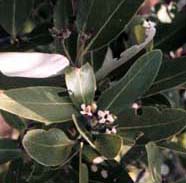
A black mangrove is an example of a halophyte, a plant that thrives in a saline environment.
|
halophyte - a plant that grows in soils that have a high content of various salts |
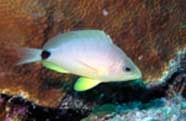
A butter hamlet photographed at Curacao (Photo: Mark Rosenstein / Active Window Productions (markrosenstein.com))
|
hamlet - any of about 10 species of small grouper in the genus Hypoplectrus (family Serranidae) that inhabit shallow reef areas in the western Atlantic.They feed mostly on small benthic crustaceans, and occasionally on small fishes. The black hamlet is a simultaneous hermaphrodite (both sexes occurring within the same individual). A mating pair takes turns acting out sex roles during courtship |
hamulus - a small hook-like projection |
haplodiplontic - having a life history that includes both haploid and diploid phases |
haploid - a haploid cell contains a nucleus with a single complete set of chromosomes. The haploid condition is often abbreviated as n. Most fungi, protists, and algae are haploid, as are some insects, bryophytes, and the gametes of all organisms |
haplotype - a set of closely linked genes that tends to be inherited together as a unit; a particular set of alleles at linked loci that are found together on a single homolog |
hapteron - a single branch within a holdfast |
hard bottom - a substrate formed by the deposition of calcium carbonate by reef building corals and other organisms or existing as bedrock or volcanic rock usually of minimal relief |
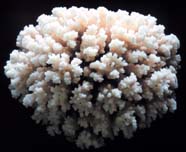
Skeleton of a hard coral colony.
|
hard coral - a coral in the anthozoan order Scleractinia. Also known as the stony corals, these organisms possess a hard external calcareous skeleton. A synonym of stony coral |
hard coral forms - may be conveniently summarized as: encrusting (lichen-like); branched (staghorn-like); massive (rock-like); sub-massive (pillar-like); tabulate (table-like); foliose (scroll-like); and solitary |
Hardy-Weinberg Law - the frequency of a given genotype will reach equilibrium in a randomly mating population and will stay constant over many generations in the absence of selection pressures |
harem - a social structure whereby several females associate and breed with a single male |
harmful algal bloom (HAB) - an increased abundance of algae that may cause illness in people or marine animals. HAB's can cause mass mortalities of marine organisms, are a public health risk, and can cause economic damage through declines in tourism, shellfish bed closures, and reductions in the market value of seafood |
harmonics - pertaining to sound, harmonics are multiples of the fundamental frequency (a single sine wave) |
harvest - to capture, catch, collect or harvest organisms by any means |
hatch - the process of an embryo leaving the egg envelopes |
hatch success - the proportion of eggs in a nest that produce live hatchlings |
hatchling - A newly hatched bird, reptile, amphibian, or fish |
haterumadienone - a bioactive derivative of puupehenone, isolated from a sponge Dysidea sp., which interferes with cell division processes |
Hawaiian Archipelago - the Hawaiian Archipelago consists of eight large islands and 124 small islands, reefs, and shoals. It stretches for over 2,400 km from 19 degrees - 28 degrees N to 155 degrees -178 degrees E. It can be divided into two distinct regions: the Northwestern Hawaiian Islands (NWHI), primarily uninhabited atolls, islands, and banks accounting for the majority of U.S. reefs, and the Main Hawaiian Islands (MHI) largely made up of populated, high, volcanic islands with non-structural reef communities, fringing reefs, and two barrier reefs |
hawser - a large rope for mooring or towing a ship |
hazardous waste - a discarded material which contains substances known to be toxic, mutagenic, carcinogenic, or teratogenic to humans or other life; ignitable, corrosive, explosive, or highly reactive alone or with other materials |
heading - the direction in which a vessel is pointed at any given moment |
heat shock proteins (HSPs) - a group of proteins that are present in the cells of all living organisms. They are induced when a cell is exposed to various types of environmental stresses, e.g.,heat, cold and oxygen deprivation. Heat shock proteins are also present in cells under normal conditions, assisting in other cellular protein functions and behavior. They also trigger immune responses through both intracellular and extracellular activities; also called stress proteins |
heavy metal - a metal having a specific gravity of 5.0 or greater. Heavy metals are generally toxic to organisms in relatively low concentrations, and tend to accumulate in the food web. Examples include arsenic, cadmium, chromium, lead, and mercury |
hectare (ha) - a metric unit of measure for area, equal to 2.47 acres |
heiau - a traditional Hawaiian place of worship; a religious shrine |
heliophilous - having an attraction for sunny places |
heliotropism - an orienting response to the sun |
heliox - a breathing gas mixture for scuba divers that contains only oxygen and helium, used for deep diving to remove the narcotic effect of nitrogen |
helix - a structure with a spiral shape |
helophilous - having an affinity for marshes |
heme - a complex red organic pigment containing iron and other atoms to which oxygen binds |
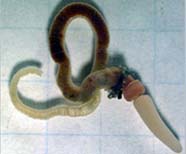
An acorn worm in the phylum Hemichordata. (Photo: BIODIDAC)
|
hemichordate - any of various worm-like marine animals belonging to the phylum Hemichordata, having a primitive notochord and gill slits |
hemipenis - a hemipenis (plural hemipenes) is one of a pair of copulatory organs of male snakes, lizards, and amphisbaenians. Only one is used during mating. Hemipenes are usually held inverted within the body and are everted for copulation |
hemocoel - the extensive spaces of an arthropod's body through which the hemolymph (blood) circulates |
hemocyanin - a bluish, copper-containing respiratory pigment with an oxygen-carrying function similar to that of hemoglobin that is present in the blood of certain mollusks and arthropods |
hemocyte - a cellular component of the blood, especially in invertebrate organisms. There are different types of hemocytes performing a variety of functions, which include defense and nutrient transport |
hemoglobin - the iron-containing protein (pigment) found in red blood cells of vertebrates. Hemoglobin transports oxygen from the respiratory surface (gills, lungs) to the body's tissues. It is red when oxidized |
hemolymph - the circulating and tissue-bathing fluid of the arthropod open circulatory system. It is composed of cells and plasma and often loosely termed as blood |
Henry's Law - the amount of gas that will dissolve in a liquid at a given temperature is almost directly proportional to the partial pressure of that gas |
hepato- - pertaining to the liver |
herbivore - an animal that feeds on plants |
heredity - the transfer of genetic information from parent cells to progeny |
hermaphrodite - an animal or plant which is equipped with both male and female reproductive organs |
hermatypic coral - a reef-building coral with zooxanthellae in its tissues |
herpetofauna - the species of amphibians and reptiles that inhabit a given area |
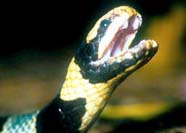
Herpetologists study the biology of amphibians and reptiles, such as this Indopacific sea snake, Laticauda colubrina. This species lays its eggs on land. Other species are livebearers and give birth to their young in the ocean. (Photo: Sohan Shetty)
|
herpetology - the scientific study of amphibians and reptiles |
hertz - unit of frequency equal to one cycle per second |
heterauxesis - disproportionate growth of a structure in relation to the rest of the body |
heterocercal - a caudal fin where the upper lobe is larger than the lower lobe. Most sharks have heterocercal caudal fins |
heterochromatin - the portion of chromosome material that remains condensed and is transcriptionally inactive during interphase of the cell cycle |
heterochrony - a change in the timing of ontogenetic events between two species. These can be the result of relatively small genetic changes between an ancestor and its descendant species |
heterodont - a type of dentition where the teeth are not all similar. For example, a mixture for special functions, such as canines, incisors and molars for piercing and tearing, snipping and grinding |
heterogeneous - consisting of dissimilar elements, parts or forms; having non-uniform structure or composition |
heterologous - derived from organisms of a different but related species |
heterosis - a situation where crossing two inbred lines yields offspring that are more healthy/vigorous than their parents; hybrid vigor |
heterotrichous - pertaining to a nematocyst with spines that vary in size |
heterotroph - an organism that cannot manufacture its own food, and therefore requires external sources of energy |
heterotypic school - a well-defined group or school of several kinds of fishes |
heterozooid - a specialized non-feeding bryozoan zooid. Heterozooids include forms specialized for producing and brooding eggs, or, more rarely, spermatozoa. Others are specialized to protect the colony, or have a cleaning function, or strengthen and support the colony |
heterozygote - an individual having a heterozygous gene pair. A diploid or polyploid with different alleles at a particular locus |
heterozygous gene pair - a gene pair having different alleles in the two chromosome sets of the diploid individual, for example, Aa |
heuristic - problem analysis based on informal judgment or experience versus data manipulation; a guideline or rule of thumb that is normally effective in dealing with a given situation |
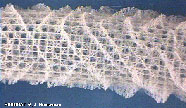
A glass sponge in the class, Hexactinellida. (Illustration: BIODIDAC)
|
Hexactinellida - a class of sponges (phylum Porifera) commonly called glass sponges, as they have distinct siliceous spicules which are united with each other and form a network. The body is usually cylindrical or funnel-shaped. Most Hexactinellida are syconoid or leuconoid in body organization. All species are marine and are rarely found at depths less than 50 meters |
hexamerous - having six parts, or parts in multiples of six arranged radially, as found in anthozoans in which the tentacles and mesenteries are in multiples of six |
hexaxon - in sponges, a spicule with six rays |
hiatus - a gap, e.g., unoccupied space between the distributions of two species or populations; a space between teeth |
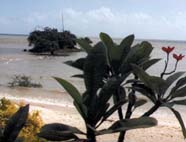
A small island at the mouth of the Amazon River at high tide. See low tide for contrast. (Photo: Alessandra and Michael)
|
high tide - the tide at its fullest extent, when the water reaches its highest level |
high-resolution satellite SST climatology - 9 km monthly or yearly averages of satellite-derived (see AVHRR) sea surface temperatures obtained over periods of 10 years or longer |
hinge - the elastic part of a bivalve (Mollusca) shell that unites the valves along the top of the shell |
histogram - a bar graph in which the area over each class interval is proportional to the relative frequency of data within this interval |
histology - the branch of biology that studies the microscopic structure of animal or plant tissues. The four basic types of animal tissues are: epithelial tissue, nervous tissue, muscular tissue and connective tissue (bone, cartilage, blood, fat, and areolar (fibrous). The three basic plant tissues are: dermal tissue, ground tissue, and vascular tissue |
histone - a type of protein present in the nucleus of eukaryotic cells that helps to compact DNA into tightly packed chromosomes |
historical data - data sets from previous studies |
histosol - soil with a high organic content |
hoa - a channel or pass connecting the atoll lagoon with the open ocean |
holdfast - a root-like structure for attachment that anchors attached seaweeds, other algae, and octocorals to the substratum |
holism - the hypothesis that the properties of a system cannot be determined or explained simply by the sum of its components alone, i.e., the total of a system is greater than the sum of its parts; as opposed to reductionism |
holobenthic - pertaining to fauna that are confined to a benthic existence throughout their entire life cycle |
holobiont (coral) - a collective term referring to the totality of a coral animal, its endosymbiotic zooxanthellae, and the associated community of microorganisms |
holoblastic cleavage - complete cleavage of the zygote. The cleavage furrows pass all the way through the zygote; typical of isolecithal and mesolecithal eggs |
Holocene epoch - an epoch of the Quaternary period dating from the end of the Pleistocene approximately 8,000 years ago until the present |
holoeuryhaline - pertains to organisms that inhabit fresh, brackish and marine waters |
holoplankton - planktonic organisms that spend their entire life cycle in the floating state, as contrasted with organisms, such as fishes, which spend only a portion of their life cycle (eggs, larvae) as members of the planktonic community |

A holothurian (sea cucumber), Holothuria atra.
|
holothurian - a sea cucumber in the echinoderm class Holothuroidea |
holothurin - a toxic substance released by some holothuroids (sea cucumbers) |
holotrichous - pertaining to a nematocyst with spines along the whole shaft or thread |
holotype - in taxonomy, a single specimen designated or indicated the type specimen by the original author at the time of publication of the original description |
home page - the first page that a browser opens when accessing a Web address (URL). The home page generally serves as a gateway to the rest of the Web site by providing links to the other pages |
home range - the area over which an animal normally travels in its daily activities |
homeobox - a region of DNA sequence found in genes involved in the regulation of the development (morphogenesis) of fungi, plants and animals. Genes that have a homeobox are called homeobox genes and form the homeobox gene family. They are also called "HOX genes." Homeobox genes regulates activities of other genes (turns genes 'on' and 'off' ) |
homeostasis - the ability to maintain a relatively constant internal environment |
homeotic gene - a gene that controls the activity of other genes involved in the development of a body plan |
homeotic mutation - a mutation that causes a body part of an organism to develop in an inappropriate position |
homing behavior - a type of behavior where the adult organism returns to its place of origin |
homocercal - a caudal fin with upper and lower lobes that are approximately equal in size; characteristic of most bony fishes |
homodont - type of dentition where the teeth are all similar, indicative of a uniform diet |
homogeneous - of similar or uniform structure or composition throughout; refers to anything which displays a uniform or consistent composition |
homolog - in genetics, one member of a chromosome pair. Homologous chromosomes have corresponding DNA sequences and come from separate parents, i.e., one homolog comes from the maternal parent and the other comes from the paternal parent; in evolution, a characteristic that is similar in different species because it evolved from a common ancestor |
homologous behavior - a behavior in different species which is similar in its manifestation, but not necessarily in function |
homologous chromosomes - the pair of chromosomes in a diploid individual that have the same overall genetic content. One member of each homologous pair of chromosomes is inherited from each parent |
homology - the relationship of any two characters that have descended from a common ancestor. The term can apply to a morphological structure, a chromosome, an individual gene, or a DNA sequence |
homonym - in taxonomy, each of two or more identical but independently proposed names for the same or different taxa. A junior homonym is the later published of two homonyms. A senior homonym is the earlier published of two homonyms |
Homonymy, Law of (Principle of) - any name that is a junior homonym of an available name must be rejected and replaced; the principle that the name of each taxon must be unique |
homotypic school - a well-defined school of fish composed of one species with individuals all of similar size |
homozygote - an individual having a homozygous gene pair. A diploid or a polyploid with identical alleles at a locus |
homozygous gene pair - a diploid gene pair having identical alleles in both copies, for example, AA or aa |
hookah - "hookah" refers to diving where the diver is supplied with breathable air from the surface via an air compressor and an airline (hose). This type of diving is ideal for shallow water commercial applications |
horizontal classification - in taxonomy, classification which stresses grouping together taxa in a similar stage of evolution, rather than location on the same phyletic line |

the longspine cowfish, Lactoria cornuta, has a pair of horns projecting from the top of its head (Photo: Keoki and Yuko Stender)
|
horn - a bony projection, e.g. the "horns" on the heads of cowfishes |
horny coral - coral species in the Order Gorgonacea that embeds calcium carbonate in a semi-soft, flexible material called keratin. This allows for the flexibility sea fans and sea whips require to survive in strong currents; gorgonians |
horotelic - pertaining to evolution proceeding at a standard rate |
horse latitudes - two belts or regions of subtropical high-pressure areas, located between 30-35 degrees north and south, in which the wind is light and varied and weather is hot and dry |
host - an organism which serves as the habitat for a parasite or symbiont. The host may provide nutrition to the parasite or symbiont, or simply a place in which to live |
hotspot - an environmentally endangered region that is both rich in species and found nowhere else |
HotSpot animation - animations from HotSpot imagery denoting coral reef bleaching events over time |
HotSpot charts - charted regions that highlight sea surface temperature (SST) anomalies that are greater than 1 deg C above the maximum monthly climatological SST. See also coral bleaching and coral bleaching hotspot |
Hox gene - a member of a family of regulatory genes which all contain a common base pair sequence, the homeobox. In morphogenesis, they are involved in spatial patterning along the longitudinal axis of an organism. The genes are activated to define the anterior end, the posterior end, the middle, etc. Their expression pattern is collinear, that is, the order of genes in the cluster reflects the temporal and spatial sequence of gene activation in the organism |
hump - the raised area behind the head in certain fish species, usually mature adults or breeding males |
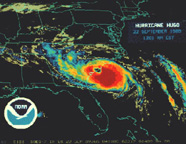
Infrared image of Hurricane Hugo making landfall September 22, 1989. (Image: NOAA)
|
hurricane - an intense tropical cyclone in which winds tend to spiral inward toward a core of low pressure, with maximum surface wind velocities that equal or exceed 33.5 m/sec (75 mph or 65 knots) for several minutes or longer at some point |

Surge from 1969's Hurricane Carol swamps a yacht club. (Photo: Providence Journal Co., NOAA/NWS Historic Collection)
|
hurricane surge - a rise in the sea surface on an open coast, often resulting from a hurricane |
hyaline - translucent or transparent |
hyalinization - a form of tissue degeneration in which the tissues develop a homogeneous and glassy appearance |
hybrid - an individual with parents of different species |
hybrid name - in taxonomy, names of progeny of two individuals belonging to different taxa. Names given to hybrids are not normally available, as they are individuals, not populations, and hence not taxa |
hybrid underwater vehicle (HROV) - an underwater vehicle designed to help marine scientists with many research needs using a single tool which can operate as an autonomous underwater vehicle (AUV) or as a tethered remotely operated vehicle (ROV) during a research cruise, depending on mission needs |
hybridization - the production of offspring (hybrids) from genetically dissimilar parents |
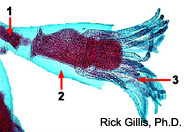
Hydranth of the hydrozoan, Obelia. 1=coenosarc; 2=hydrotheca; 3=tentacles. (Photo: Rick Gillis, Ph.D., Biology Dept., University of Wisconsin-La Crosse)
|
hydranth - a feeding polyp of a colonial hydrozoan. It bears tentacles armed with nematocysts, a mouth and a thin outer covering, the hydrotheca |
hydrate - a compound produced when certain substances chemically combine with water; as a verb, it means to supply water to something that absorbs it |
hydraulic hypothesis - the hydraulic hypothesis (or "theory") attempts to explain the formation and existence of Lophelia coral reefs in deep, cool, Norwegian waters. It states that primary producers (mainly bacteria) are locally formed and concentrated at reef locations due to seepage of light hydrocarbons (mainly methane) on the continental shelf, and nutrient-rich groundwater in the fjords. The health and proliferation of these deep water reefs relies on the assumption that there is a stable, local input of nutrients through the seabed at or near the location where the reefs are found |
hydrocarbon - an organic molecule, such as methane (CH4), which consists only of carbon and hydrogen atoms |
hydrocarbon seep - an area where hydrocarbons seep slowly from the sea floor |
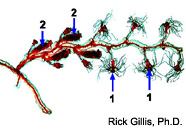
Hydrocaulus of the hydrozoan, Obelia. (Photo credit: Rick Gillis, Ph.D., Biology Dept., University of Wisconsin-La Crosse)
|
hydrocaulus - the main stem of a colonial hydrozoan which consists of a cylindrical tube of living tissue (coenosarc) covered by a thin outer membrane (perisarc) |
hydrochory - spread of plant seeds, spores or propagules by water |
hydrocoral - a cnidarian, belonging to the class Hydrozoa, which contains an internal skeleton of calcium carbonate, unlike therelated hydroids, whose skeleton is chitinous and external. Hydrocorals, which include fire coral and the precious red coral used for jewelry, form encrusting or branching skeletons similar to those of anthozoan corals |
hydrogen bond - a relatively weak chemical bond consisting of a hydrogen atom between two electronegative atoms (e.g., oxygen or nitrogen), with one side being a covalent bond and the other being an ionic bond |
hydrogen ion - an individual atom of hydrogen which is not attached to a molecule and therefore has a positive (+) charge |
hydrogen sulfide (H2S) - a toxic gas formed by the anaerobic decomposition of organic matter. It's chemical formula is H2S. It is a common chemical found in the fluids of hydrothermal vents formed when seawater is exposed to the sulfate in volcanic rock below the ocean floor. Hydrogen sulfide is colorless with a strong odor of rotten eggs |
hydrogenosome - an organelle found in ciliates, trichomonads, and fungi. Hydrogenosomes are enclosed by a membrane and produce molecular hydrogen and ATP. They are thought to have most likely evolved from mitochondria |
hydroid - a body shape of cnidarian polyps. A hydroid has a fleshy central stalk topped by a ring of tentacles used for catching food. Anemones are one kind of hydroid; many jellyfishes are hydroids for part of their life cycle |
hydrological cycle - the movement of water in all of its phases (gas, liquid, solid) from the Earth to the atmosphere and back to the Earth |
hydrology - the science dealing with the properties, distribution and circulation of water and snow |
hydrolysis - the breaking down of a compound into fragments by the addition of a molecule of water. The hydroxyl group is incorporated in one fragment and the hydrogen atom in the other |
hydrophilic - having a strong affinity for water; tending to dissolve in, mix with, or be wetted by water - |
hydrophobic - refers to molecules that do not interact with water and are not soluble in water. Hydrophobic compounds do not dissolve easily in water, and are usually non-polar. Oils and other long hydrocarbons are hydrophobic |
hydrophone - an underwater microphone |
hydropic - having an excess of water or watery fluid |
hydrorhiza - all structures by which hydrozoan polyps are attached to the substrate |
hydrosere - an ecological succession beginning in a habitat with abundant water, typically on the submerged sediments of a standing water body (e.g. lake or lagoon), and ending on dry land |
hydrostatic pressure - the pressure exerted by the weight of fluids. As depth increases in water, the pressure also increases due to an increased column of water above the point in question; the pressure exerted at a given depth by the weight of the overlying column of water |
hydrostatic skeleton - a type of skeleton found in many soft-bodied invertebrates which consists of a turgid column of liquid within one of the body spaces that provides support or rigidity to the organism or to one of its parts. Hydrostatic skeletons are found in echinoderms (starfish, sea urchins), annelids (worms), nematodes (roundworms), and a number of other wormlike invertebrate phyla |
hydrotheca - a thin outer covering of a hydranth, the feeding polyp, of a colonial hydrozoan |
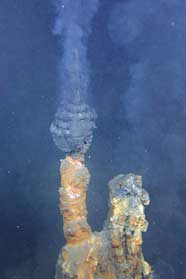
A "black smoker" chimney on the Brothers seamount on the Kermadec Ridge, emitting a hot hydrothermal plume of mineral rich fluid (Photo: Japan Agency for Marine-Earth Science and Technology (JAMSTEC))
|
hydrothermal plume - a cloud of hot, mineral-rich water that flows out of a hydrothermal vent and disperses into the ocean, usually several hundred meters above the seafloor vent site. Rock particles and minerals in the plume water often make the plume look smoky |
hydrothermal vent - a sea floor fissure from which a spring of geothermally heated mineral and gas rich seawater issues. Hydrothermal vents are found on some oceanic ridges in zones of active seafloor spreading (plate tectonics) |
hydroxyl group - an [-OH] or alcohol group on a larger molecule. The oxygen is single-bonded to the hydrogen and has one free bond to the rest of the molecule |
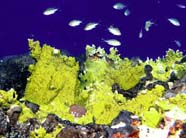
White-tipped mustard-colored fire coral in the Flower Garden Banks.
|
Hydrozoa - a class within the phylum Cnidaria. The Hydrozoa contains five orders that include: small medusae with no polyp generation; colonial forms with alternating polyp and medusa stages and a chitinous exoskeleton; solitary polyps that lack a medusoid stage; colonial forms with massive aragonite skeletons (e.g., fire coral); and complex colonial forms, with individual polyps specialized for feeding, swimming, prey capture, and reproduction. Some, but not all, float by means of a large pneumatophore, or gas bag |
hyoid - having a "U" shape |
hyper- - above, exceeding, higher, more than, abnormally increased |
hypereosinophilia - a disease characterised by a marked increase in the eosinophil (a type of white blood cell) count in the blood |
hyperlink - text or images on a Web page that, when clicked with a mouse, causes the browser to load another page of html. Because a simple mouse click allows the user to easily go from one page of hypertext to another, these pages are said to be "hyperlinked." Text links are usually, but not always underlined in blue, while hyperlinks that are images often take the form of "buttons" |
hyperplasia - abnormal increase in the size/volume of a tissue due to multiplication of cells |
hypersaline - referring to water with a salinity higher than that of natural seawater |
Hyperspectral AVIRIS (Airborne Visible/Infrared Imaging Spectrometer) - a hyperspectral image is a very high resolution image which was acquired with a hyperspectral scanner. These instruments acquire data in 224 contiguous channels of approximately 10nm bandwidth. They are spanning the visible, near-infrared and mid-infrared portion of the electromagnetic spectrum |
hypertrophy - the over-development of a structure |
hypertrophy - the excessive enlargement or development of an organ or tissue, with increase in cell size but without increased cell division |
hypha - one of the long, branching filaments that forms the mycelium of a fungus |
hypo- - under, below, beneath, lower than, small size, deficiency |
hypobranchial gland - a gland in the mantle cavity of mollusks that secretes mucus |
hypocenter - the point under the earth's surface where the energy of an earthquake is first released. The point directly above the hypocenter on the earth's surface is the epicenter |
hypolithic - living on lower surfaces of rocks |
hyposaline - referring to water with a salinity lower than that of natural seawater |
hypostome - in cnidarians, the circular raised area of a hydrozoan polyp that lies between the tentacles and the mouth. The term is also used to describe mouthparts in other phyla |
hypothermia - a condition when the body temperature is colder than normal (37 degrees C/98.6 degrees F in humans) |
hypothesis - a tentative assumption made for the purpose of empirical scientific testing. A hypothesis becomes a scientific theory when repeated testing and the great body of evidence suggests that the hypothesis has a stong probability of being correct |
hypoxic - deficient in oxygen |

The hypural plate is the expanded ends of the hypurals that form a wide, fan-like plate onto which the caudal fin rays are attached (Illustration: Fishbase)
|
hypural plate - in fishes, the flattened bony plate at the posterior end of the vertebral column |
|
|
|
|

